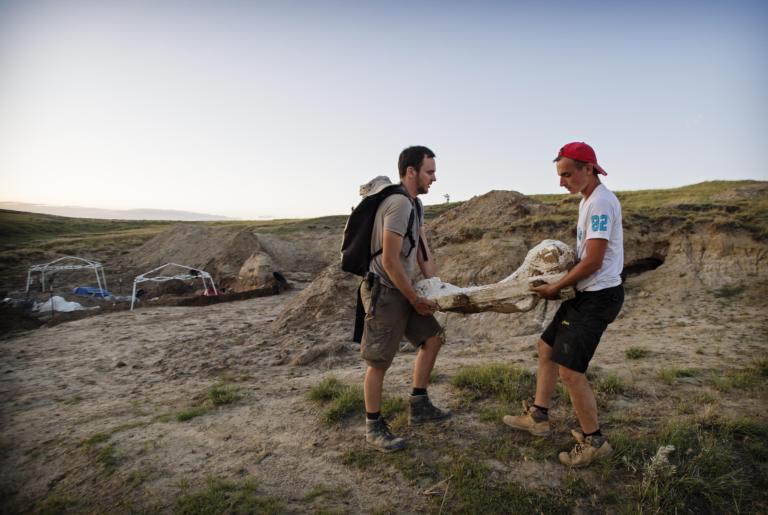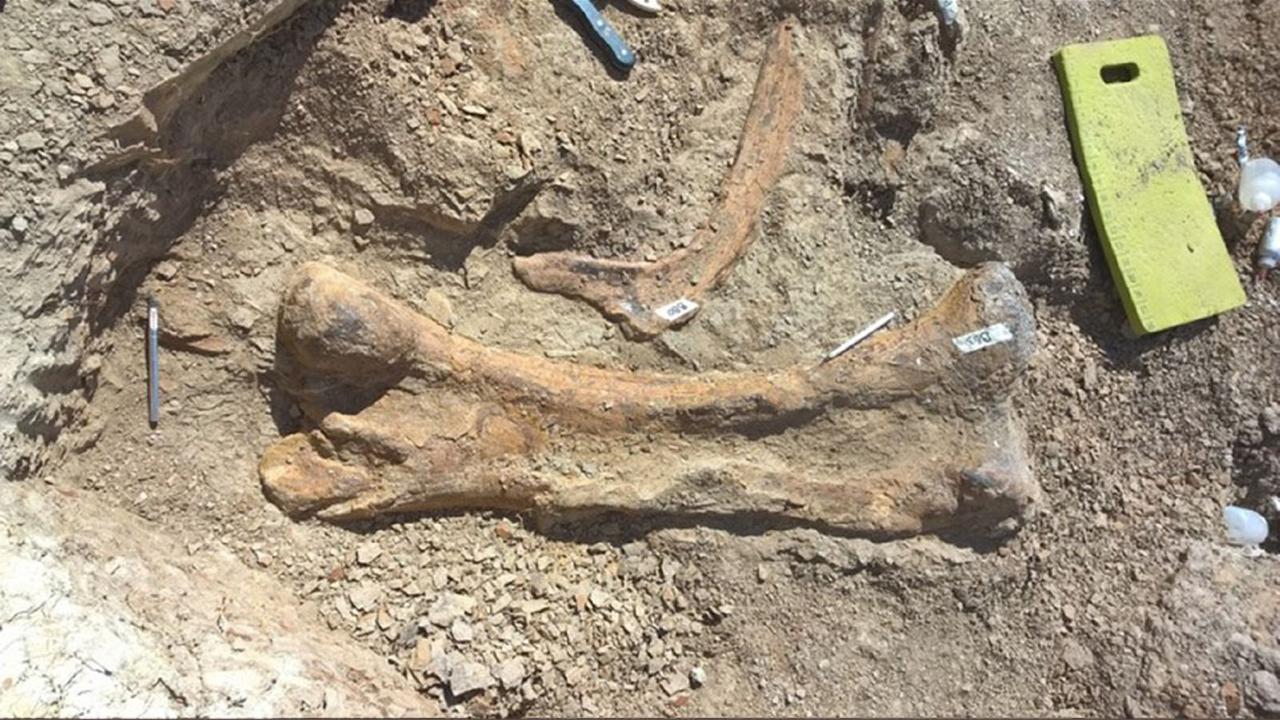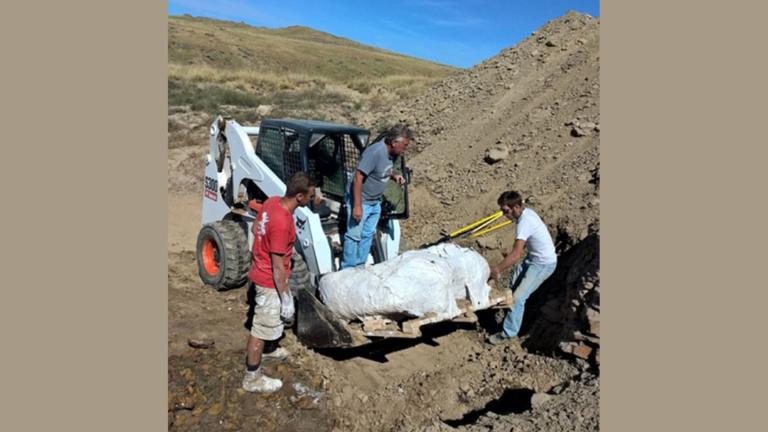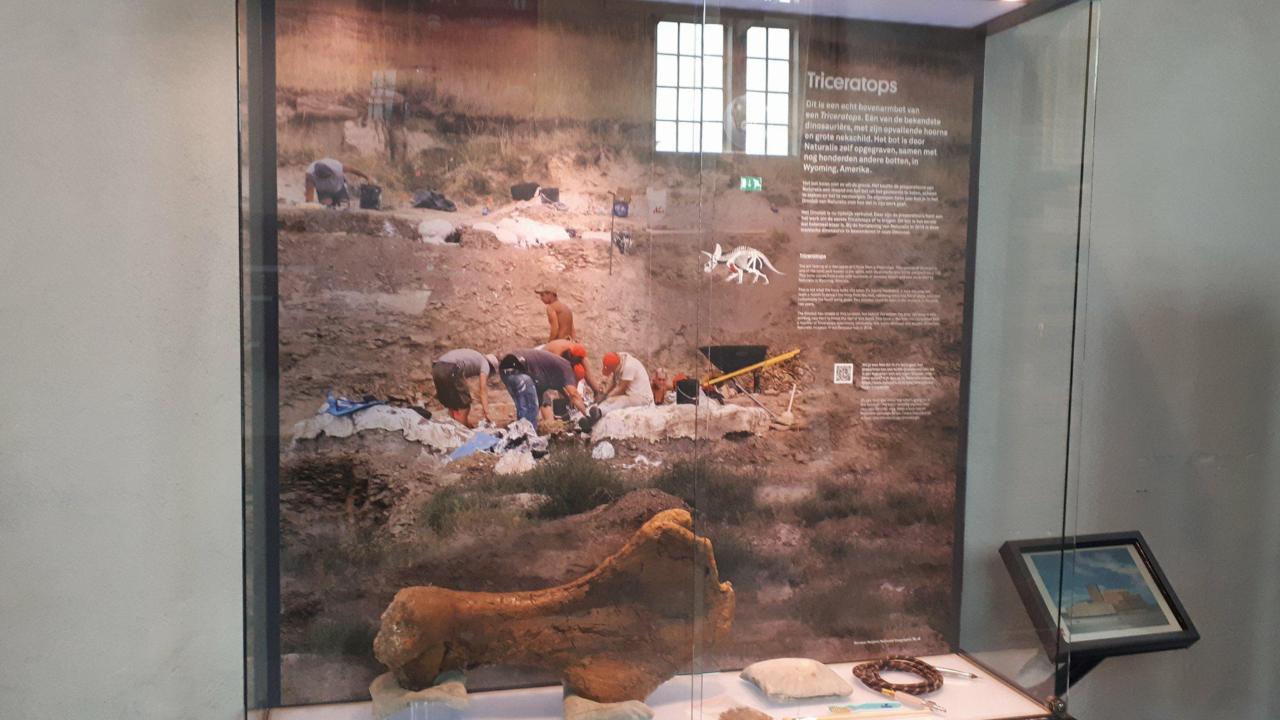
Triceratops, or literally: three-horned face, an iconic dinosaur. Once upon a time, in 2013, researchers from Naturalis made a special discovery. In Wyoming (America) they found the remains of several Triceratopses. Three more expeditions followed and over a thousand bones were excavated. The adventures of our dino experts could be followed in blogs and video reports. In this blog we summarize their adventures, tell you what happened to the bones and look forward to our new museum ...
2013
A total of 200 bones were excavated.
In a rock formation on a ranch in Wyoming, America, the remains of Triceratops are found (the favorite meal of T. rex). This is a very special discovery: it turns out to be multiple specimens. Both young animals and adults, together (in a group?). One of the older animals is in very good condition and almost complete! Dinosaur expert Anne Schulp explains: "We are especially curious about everything behind the skull: the neck, back, hips and legs. We are so lucky that we found all of that ond this site. This is extremely rare, bacause usually T. rex ate its prey with skin and hair and bone. Therefore there weren't many bones left after it's meal. Skulls, however, it often left, because they hold little meat."
The bones are carefully excavated and then immediately wrapped with plaster and taken out. This must be done as accurately as possible, because the material is very fragile. Such special bones must of course not be damaged! After the excavation, the bones are safely wrapped in a plaster cast to enable them to be transported to Naturalis in the Netherlands. In the Naturalis Dinolab, the bones will be nicely prepared: cleaned, reinforced and where necessary, the missing pieces, holes and cracks are completed. An accurate and time-consuming job.
2015
In total, at least five different Triceratops were found on the excavation site.
"We counted already four hundred bones and new material keeps appearing. Never before has such a group been found. The animals are of different sizes: youngsters and adults, "says Anne Schulp enthusiastically. "There is also an individual with a huge crest on its skull!" The fact that they were found together, tells us a little bit more about how these dinosaurs lived. "They might have meeted or lived a part of their life together. Whether that is due to migration or that they lived in groups, these fossils canhelp uns answer that question", says Dylan Bastiaans of the Triceratops Team.


Triceratops are such interesting dinosaurs because different individuals do not look alike at all. Really every individual is different. So with every discovery that is made, the picture that we have of them changes a bit. Consider what changes five individuals bring!
Eventually, over 600 bones are uncovered, are wrapped in plaster and sent to the Netherlands. Despite the hard work, not everything could be excavated. It is simply a monster job. Sometimes the bones are so close together that they are difficult to dig out. It also becomes too heavy to be taken out of the ground as one block. This requires coarser material, more insight about what is around the bones and simply more time. The remaining bones are therefore well covered for the winter. The expedition members will return again in 2016 to dig up the last bones (such as a piece of neck shield from a young adult dinosaur).
In ten full crates the first bones from America arrive at Naturalis. In the specially constructed Dinolab, in the middle of the museum, the bones are being prepared. Our visitors can watch live and bombard the team with questions.
2016
Fortunately, all the bones have survived the winter being well covered with tarp and a thick layer of sand. A few hundred bones to go... Throughout the month of June, the Triceratops Team works non-stop to excavate these treasures.
The bones are at two different depths. Geologists are trying to find out how some bones have ended up at the bottom level, while others are at the upper. Another team investigates how far the upper bone field stretches. Some new bones are being discovered, but these are really the last ones. However, a nice underarm bone is still exposed. With that, quite a few bones of the Triceratops in the upper layer, now called 'Dirkje' by the researchers (after one of the volunteers at the excavation and dinolab) were excavated. That will certainly become a beautiful skeleton!
The weather goes all but: heat, rain, hard wind and even hailstones as big as chocolate Easter eggs. It doesn't make the work easier, but the researchers continue. An important piece of skull is found, but also the little jaw of a small mammal and the tooth of a carnivorous dinosaur. In the last week there is no longer being searched for new bones, but the maximum are being dug out, so that they do not remain in harsh winter conditions. Five boxes are filled with bones and are readied to be transported to Naturalis.
After three expeditions the final amount is 900 bones. Some are still in great condition, others more weathered or broken. Work in store for the Dinolab!
2017 & 2018
The Dinolab preparers work hard on the bones. By the end of 2017, the five crates of the last expedition arrive at Naturalis.
The first bone is now fully prepared: it is completely clean and tidy and is being exhibited in the museum. Due to the renovation, the Dinolab has moved temporarily and is no longer situated in the museum. Behind the scenes, the preparers are still working hard to finish all the bones. After this is done, the big puzzle work begins: the loose bones must be assembled together to become multiple skeletons.
After the summer of 2019, these beautiful Triceratops can be admired in the dinosaur exhibition hall of our brand new museum. Will you also take a look? Until then, we will keep you informed in our blogs. See you in 2019!

Written by Hilde Pracht,
Communication Department, Naturalis Biodiversity Center
24-01-2018